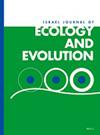甲虫物种多样性-生产力关系的尺度独立性:空间异质性排列的重要性
IF 0.8
4区 环境科学与生态学
Q3 ECOLOGY
引用次数: 0
摘要
物种多样性与生产力的关系通常(但不总是)依赖于规模。我们假设沿降雨梯度的环境异质性的排列,作为生产力的替代物,决定了我们的沙质场地甲虫多样性是否存在尺度依赖性。我们选择了7个地理上遥远的景观(从南到北360公里),平均年降雨量在30-585毫米之间,每个景观都有6个由5个均匀分布的陷阱组成的集群(在0.24平方公里的范围内)。在每个景观及其集群中测量植被和物理变量,以表征空间和时间异质性。我们将每个集群的物种多样性和景观的累积物种多样性分别作为局部和区域多样性。群落间多样性差异反映了景观内物种的更替。我们分别使用每个集群和整个景观的环境指标来表示局部和区域异质性,并使用样带之间的变化来表征景观内部异质性的差异。在两个空间尺度上,甲虫多样性和生产力均呈现单峰模式,在中等生产力约300 mm处达到峰值。环境异质性在局地和景观尺度上均随生产力的增加而增加,但景观内部异质性不随生产力的增加而变化。在中等生产力水平上,集群间多样性差异较大,解释了景观尺度上的单峰格局。我们认为,我们研究中的尺度独立性源于景观内环境异质性的均匀分布。我们建议,跨尺度的多样性-生产力关系的探索应该考虑异质性沿生产力梯度的分布方式。本文章由计算机程序翻译,如有差异,请以英文原文为准。
Scale-independence in beetle species diversity-productivity relationship: The importance of heterogeneity arrangement in space
Species diversity-productivity relationship is often, but not always, scale dependent. We hypothesize that the arrangement of environmental heterogeneity along a rainfall gradient, as a surrogate for productivity, determines whether scale dependence of beetle diversity at our sandy sites exists. We chose seven geographically distant landscapes (360 kms from south to north) within a mean annual rainfall range of 30–585 mm, each having six clusters of five uniformly distributed pitfall traps (within a range of 0.24 km2). Vegetation and physical variables were measured within each landscape and its clusters to characterize both spatial and temporal heterogeneity. We used species diversity of each cluster and the accumulative species diversity in a landscape as local and regional diversity, respectively. Between-clusters dissimilarity in diversity reflected the turnover of species within a landscape. We used environmental measures in each cluster and at the entire landscape to indicate local and regional heterogeneity, respectively, and changes between transects to characterize the within-landscape dissimilarity in heterogeneity. Beetle diversity and productivity showed a unimodal pattern at both spatial scales, with a peak at intermediate productivity of ca. 300 mm. Environmental heterogeneity increased with productivity both at the local and at the landscape scales, but within-landscape dissimilarity in heterogeneity did not change with productivity. Between-clusters dissimilarity in diversity was higher at intermediate productivity, explaining the unimodal pattern at the landscape scale. We suggest that the scale independence in our study results from the equal distribution of environmental heterogeneity within a landscape. We propose that the exploration of the diversity-productivity relationship across scales should consider the way heterogeneity is distributed along the productivity gradient.
求助全文
通过发布文献求助,成功后即可免费获取论文全文。
去求助
来源期刊

Israel Journal of Ecology & Evolution
环境科学-进化生物学
CiteScore
2.10
自引率
0.00%
发文量
7
审稿时长
>36 weeks
期刊介绍:
The Israel Journal of Ecology and Evolution includes high-quality original research and review papers that advance our knowledge and understanding of the function, diversity, abundance, distribution, and evolution of organisms. We give equal consideration to all submissions regardless of geography.
 求助内容:
求助内容: 应助结果提醒方式:
应助结果提醒方式:


